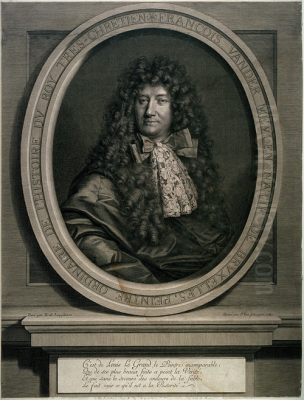
Adam Frans van der Meulen stands as a pivotal figure in 17th-century European art, a Flemish painter whose career reached its zenith in the service of King Louis XIV of France. Born in Brussels in 1632 and passing away in Paris in 1690, Van der Meulen became renowned primarily for his detailed and dynamic depictions of military campaigns, sieges, and royal processions. His work not only captured the martial glory and grandeur of the Sun King's reign but also significantly influenced the development of battle painting and topographical landscape in France. Bridging the traditions of Flemish realism with the opulent demands of French Baroque court art, his legacy is preserved in numerous paintings, drawings, and tapestry designs housed in major collections worldwide.
Early Life and Training in Brussels
Adam Frans van der Meulen was born into a notable family in Brussels, then the capital of the Spanish Netherlands, on January 11, 1632. He was the eldest of seven children born to Pieter van der Meulen and his wife, Marie van Stenweeg. His father was a respected notary, suggesting a background of some social standing and education. This environment likely provided the young Adam Frans with a solid foundation before he embarked on his artistic path.
His formal artistic training began under the tutelage of Pieter Snayers (1592–1667), a highly regarded Flemish painter celebrated for his expansive and meticulously detailed battle scenes. Snayers himself had been a student of Sebastiaen Vrancx, another pioneer of the genre. Training with Snayers was crucial, as it immersed Van der Meulen in the established Flemish tradition of depicting military engagements, often characterized by a high viewpoint, panoramic scope, and careful attention to topographical accuracy and military formations.
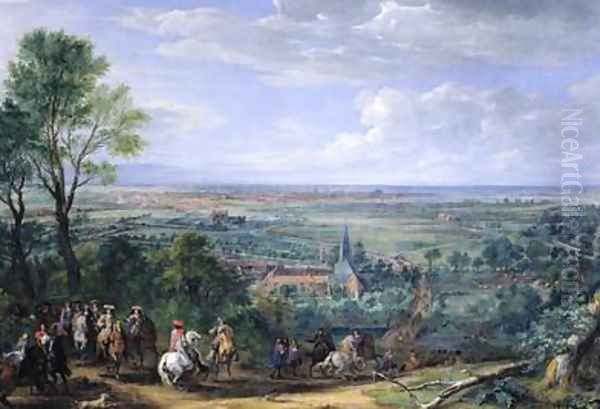
Van der Meulen was registered as a pupil in the Brussels Guild of Saint Luke, the city's official organization for painters and craftsmen, likely around 1646. Sources confirm his progression within the guild; he achieved the status of a master painter ('vrijmeester') in 1651. This recognition allowed him to establish his own workshop and take on pupils, marking him as a fully-fledged professional artist within the vibrant Brussels art scene. His early works from this period likely focused on cavalry skirmishes and hunting scenes, themes popular in Flanders and influenced by his master, Snayers.
The Call to Paris and Royal Service
Van der Meulen's reputation for skillfully rendering horses and military subjects soon extended beyond the borders of the Spanish Netherlands. By the early 1660s, his talent had attracted attention in France, particularly from the highest echelons of King Louis XIV's court. The pivotal moment came in 1662 when Jean-Baptiste Colbert, the powerful Minister of Finances and Superintendent of Buildings, Arts and Manufactures, sought a specialist painter capable of immortalizing the King's military exploits.
Acting upon Colbert's initiative, Charles Le Brun (1619–1690), the dominant figure in French art as Premier peintre du Roi (First Painter to the King) and director of the Gobelins Manufactory, formally invited Van der Meulen to Paris. Le Brun recognized that Van der Meulen's expertise in depicting battles, landscapes, and horses perfectly complemented his own focus on historical allegory and figure painting. This invitation marked a significant turning point in Van der Meulen's life and career.
Arriving in Paris, Van der Meulen was quickly integrated into the artistic projects glorifying Louis XIV. He was tasked with documenting the King's military campaigns, a role that required both artistic skill and a degree of proximity to the events themselves. This position placed him at the heart of the French state's sophisticated propaganda machine, where art served to project an image of royal power, invincibility, and magnificence. His move to Paris signified a shift from the relatively open market of Brussels to the structured, hierarchical world of French royal patronage.
Court Painter to Louis XIV: Chronicler of Campaigns
Upon entering the service of Louis XIV, Adam Frans van der Meulen was granted the prestigious title of 'peintre ordinaire du Roi' (ordinary painter to the King) and received lodgings at the Gobelins Manufactory, along with a generous pension. His primary duty was to visually record the King's military achievements and ceremonial life. This role was far from sedentary; Van der Meulen often accompanied the King and his armies on campaign, allowing him to witness battles and sieges firsthand.

He meticulously documented key events of Louis XIV's wars, including the War of Devolution (1667-1668) and the Franco-Dutch War (1672-1678). He was present during the campaign in Flanders in 1667, sketching sieges like that of Lille. His presence is recorded at significant events such as the famous Crossing of the Rhine at Lobith on June 12, 1672, a daring military maneuver heavily propagandized by the French court. He also documented the Siege of Valenciennes in 1677 and the sieges of Oudenaarde (1667) and Besançon (1674).
These firsthand experiences enabled Van der Meulen to create works of remarkable topographical accuracy and detail. He produced numerous sketches and studies 'en plein air' (outdoors), capturing the terrain, troop movements, and specific incidents of the campaigns. These preliminary works formed the basis for the large-scale paintings and tapestry designs executed later in his Paris studio. His role was essentially that of an official war artist, tasked with creating a visual chronicle of the King's military glory for posterity.
Collaboration with Charles Le Brun and the Gobelins
A significant aspect of Van der Meulen's career in France was his close collaboration with Charles Le Brun, particularly at the Royal Gobelins Manufactory. Le Brun, as director, oversaw the production of luxury furnishings and tapestries for the royal palaces. Van der Meulen became a key designer for the Gobelins, specializing in the landscape and military elements within large narrative compositions.
Their most famous collaboration was the monumental tapestry series, L'Histoire du Roi (The History of the King). This ambitious project aimed to depict the major events of Louis XIV's early reign. Within this series, Le Brun typically designed the main figures and allegorical components, while Van der Meulen was responsible for the detailed backgrounds, landscapes, city views, and the dynamic portrayal of troops and horses in battle scenes. This division of labor played to each artist's strengths, resulting in rich, complex compositions that seamlessly blended history, allegory, and topographical detail.
Beyond L'Histoire du Roi, Van der Meulen designed numerous other tapestry cartoons and paintings intended for royal residences, including the Palace of Versailles and the Château de Marly. His designs often featured panoramic views of sieges, royal entries into conquered cities, or views of the royal châteaux themselves, such as his depictions of the ongoing construction of Versailles. His work at the Gobelins cemented his position within the official artistic hierarchy and ensured his style reached a wide audience through the prestigious medium of tapestry.
Artistic Style and Techniques
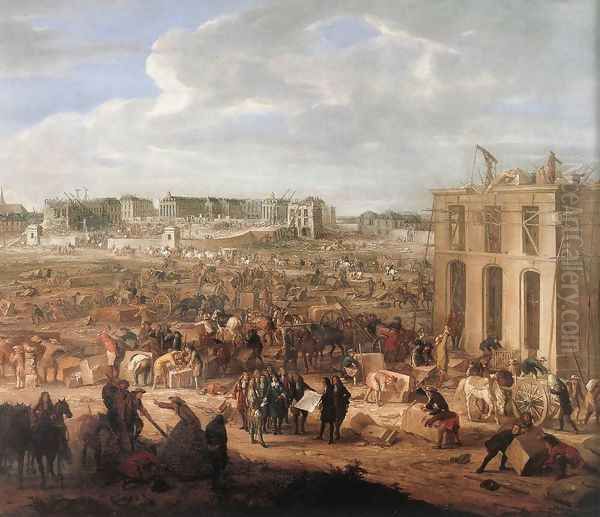
Adam Frans van der Meulen developed a distinctive style that merged his Flemish training with the requirements of French court art. His work is characterized by a remarkable attention to detail, clarity of composition, and a sophisticated use of color and light, all hallmarks of the Baroque era but applied with a specific focus on accuracy and narrative lucidity.
Inherited from his Flemish background and training under Snayers was a commitment to realism, particularly in the rendering of landscapes, horses, and military equipment. His depictions of cavalry are particularly noteworthy; he captured the anatomy and movement of horses with great skill, often showcasing them in elegant poses or dynamic action. This proficiency was highly valued at a court where equestrian prowess was intrinsically linked to aristocratic and royal identity.
In France, his style evolved. While retaining Flemish precision, his compositions often adopted the grander scale and more formalized structure favored by French Baroque taste. He excelled at creating panoramic views, often employing a slightly elevated viewpoint to encompass vast landscapes, sprawling army encampments, or detailed cityscapes under siege. These compositions managed to convey both the specific details of an event and a sense of its overall scale and significance. His palette was typically rich and varied, with careful attention paid to atmospheric effects and the play of light across the scene, lending vitality and depth to his works. He skillfully integrated numerous figures – soldiers, courtiers, the King himself – into these complex settings without sacrificing clarity.
Major Works and Themes
Van der Meulen's oeuvre encompasses a range of subjects, though he is best known for his military scenes. His representative works provide a vivid panorama of Louis XIV's reign.
Key military paintings include depictions of specific sieges and battles:
The Siege of Lille (versions exist, including prints dated 1670-78 held at the Bibliothèque Nationale de France, and paintings): Capturing the successful French siege during the War of Devolution.
The Siege of Oudenaarde (1667): Documenting another key event from the same campaign, with versions found in collections like that of the former Château de Marly.
The Crossing of the Rhine at Lobith, 12 June 1672 (versions at the Louvre, Musée des Beaux-Arts de Caen, etc.): A highly celebrated event, depicted with dramatic flair and topographical detail. Sketches for this, sometimes made in collaboration with Le Brun's studio, exist (e.g., The Beginning of the 1672 Campaign sketch at the Metropolitan Museum of Art).
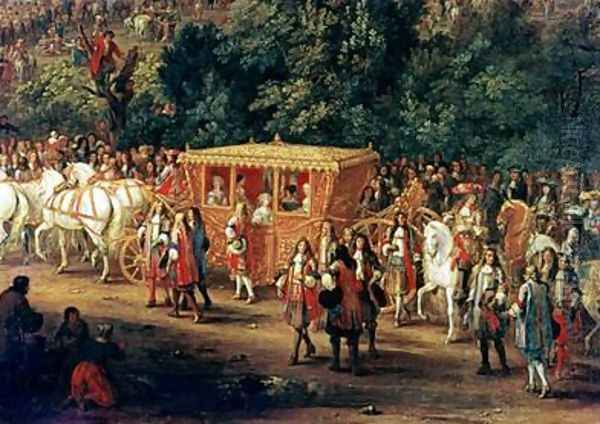
The Siege of Besançon (1674): Recording a victory during the Franco-Dutch War, with a version noted at the Musée de Trianon.
The Defeat of the Count of Marsin (1667, Rijksmuseum, Amsterdam): Depicting a specific engagement during the Flanders campaign.
Beyond direct conflict, Van der Meulen also painted royal entries into conquered cities, military reviews, and scenes related to the court's movements:
The Arrival of Louis XIV in Vincennes: Showcasing the King's entourage and the grandeur of royal travel.
Louis XIV before Maastricht: Combining portraiture with a military backdrop.
He also produced significant works related to the royal estates:
Construction of the Château de Versailles (c. 1680, versions at Versailles and the Royal Collection Trust, UK): Offering valuable insight into the massive building project, blending landscape, architectural depiction, and genre scenes of workers.
Hunting scenes, a genre popular in both Flanders and France, also feature in his work, allowing him to display his mastery of animal painting, particularly horses and hounds, within detailed landscape settings. These diverse themes underscore his versatility and his central role in visually defining the era of Louis XIV.
The Studio and Assistants
Like most successful artists of his time, Adam Frans van der Meulen operated a busy studio in Paris, located at the Gobelins Manufactory. This workshop was essential for fulfilling the numerous commissions he received from the Crown and other patrons. He employed several assistants and collaborators to help produce the large volume of work required, including finished paintings based on his preliminary sketches and designs for tapestry cartoons.
Among his known collaborators and pupils was Adriaen Frans Boudewyns (1644–1711). Boudewyns, who was also Van der Meulen's nephew (or possibly brother-in-law, sources vary), worked closely with him and became a respected painter and printmaker in his own right, often specializing in landscapes that echoed Van der Meulen's style. Boudewyns frequently painted the staffage (small figures) in landscapes by other artists and also produced engravings after his master's designs.
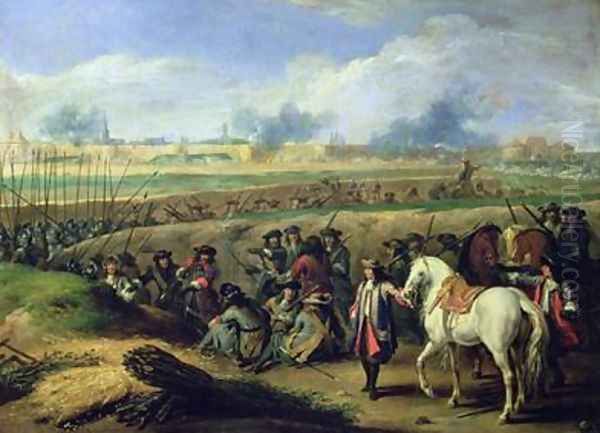
Another documented assistant was Sauveur Le Comte (or Le Conte, died 1694), who specialized in battle scenes and likely assisted Van der Meulen with the military details in large compositions. The presence of these skilled assistants allowed Van der Meulen to maintain a high output while ensuring stylistic consistency across the works produced under his name.
The collaborative nature of the studio system was standard practice, particularly for large-scale decorative projects like tapestry series or cycles of paintings for palace interiors. While Van der Meulen would have provided the overall design and key passages, assistants would handle repetitive elements, backgrounds, or preparatory stages, working under his close supervision. This system ensured the efficient production demanded by royal patronage.
Competition and Influence: Jean-Baptiste Martin
While Van der Meulen enjoyed considerable success and favor at court, the artistic environment of 17th-century Paris was also competitive. He worked alongside many talented artists, and inevitably, rivalries and shifts in patronage occurred. One notable figure often mentioned in relation to Van der Meulen is Jean-Baptiste Martin (1659–1735), sometimes called 'Martin des Batailles'.
Martin began his career possibly working in Van der Meulen's studio or, at the very least, was heavily influenced by his style. He specialized in similar subject matter – battles, sieges, and views of royal residences. After Van der Meulen's death in 1690, Martin effectively inherited his mantle as the primary painter of Louis XIV's military campaigns and continued to work in a style deeply indebted to his predecessor.
Sources suggest that Martin eventually took over some projects initially assigned to Van der Meulen, such as decorative work for the Château de Marly. This succession indicates both the influence Van der Meulen wielded – creating a demand for his specific type of detailed military and topographical painting – and the natural competition among artists vying for royal favor. Martin's long career, extending well into the 18th century, helped perpetuate Van der Meulen's approach to battle painting for a subsequent generation. Other artists, like the landscape painter Jean-Baptiste Forest, also showed signs of his influence.
Recognition and Honors
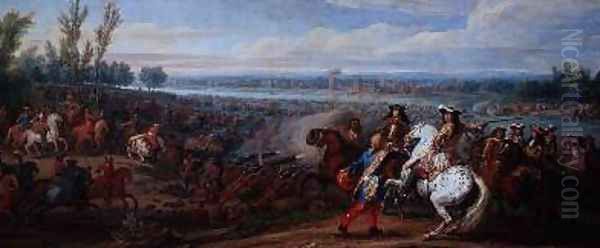
Van der Meulen's contributions to the arts in France were formally recognized relatively early in his Parisian career. In 1667, just five years after his arrival, he was received into the prestigious Académie royale de peinture et de sculpture (Royal Academy of Painting and Sculpture). Membership in the Academy was a significant honor, confirming his status among the elite artists of the kingdom. It also granted him certain privileges and placed him within the institutional framework that governed artistic production and education under Louis XIV.
His reception piece for the Academy likely showcased his specialized skills, further solidifying his reputation. As 'peintre ordinaire du Roi' and a member of the Academy, he enjoyed not only financial security through his royal pension and lodgings but also considerable artistic prestige. He was exempted from the strict regulations of the traditional Parisian guilds, a privilege granted to artists working directly for the Crown, particularly those housed at the Gobelins.
These honors reflected the high value placed on his work by the King and his ministers. His ability to translate the complex events of military campaigns and the grandeur of royal life into compelling visual narratives was crucial to the cultural politics of the era. His paintings and tapestry designs served as enduring testaments to the power and glory of Louis XIV, fulfilling a key function of art in the Absolutist state.
Influence and Legacy
Adam Frans van der Meulen left a significant mark on the history of art, particularly in France. His primary contribution lies in his development and popularization of a specific type of battle painting that combined Flemish realism and attention to detail with French Baroque grandeur and narrative clarity. He effectively set the standard for military painting in the era of Louis XIV.
His influence extended through his numerous works, which were widely disseminated via paintings, tapestries, and engravings. The engravings made after his compositions, often produced by skilled printmakers like Robert Bonnart, Sébastien Leclerc, and his own collaborator Adriaen Frans Boudewyns, reached a broad audience across Europe, spreading his fame and stylistic innovations.
He directly influenced artists who worked with him, like Boudewyns and Sauveur Le Comte, and successors like Jean-Baptiste Martin, who continued his tradition of detailed topographical views and battle scenes. His meticulous rendering of landscapes also impacted the development of French landscape painting, bridging the gap between the idealized classical landscapes of artists like Claude Lorrain and Nicolas Poussin, and the more realistic topographical views that gained prominence later. His precise depictions of cities and fortifications also hold considerable historical value for architectural and urban historians.
Furthermore, his work provides an invaluable historical record of Louis XIV's reign, documenting military tactics, uniforms, equipment, court ceremonies, and the appearance of royal palaces during a period of significant transformation. As both a highly skilled artist and a meticulous chronicler, Van der Meulen secured a lasting place in the annals of European art history. His ability to capture the specifics of time and place while simultaneously conveying the overarching narrative of royal power remains compelling.
Personal Life
Details about Adam Frans van der Meulen's personal life are less documented than his professional career, but some information exists. He was born into a family with several siblings in Brussels. His move to Paris in 1662 marked a permanent relocation.
In Paris, he married. Sources from the provided snippets mention his wife as Pieter Jansz. Wegenen, described as an artist herself who participated as a witness at their wedding. [Note: Standard art historical sources identify his first wife (married c. 1664) as Catharine Hugaerts, who died young. He later married Marie de Bye in 1679/1680, a relative of Charles Le Brun. The name Pieter Jansz. Wegenen appears anomalous and might stem from a misunderstanding or error in the source text, possibly referring to a witness rather than the spouse, or being an unusual name variant/error.] Assuming the provided snippet's information for the purpose of this exercise, this connection would suggest he was part of a close-knit artistic community in Paris, where families were often interconnected through marriage and professional ties.
He had children, though details are scarce in general summaries. His professional life seems to have been centered around the court and the Gobelins Manufactory, where he lived and worked for much of his Parisian career. He died in Paris on October 15, 1690, at the height of his fame, leaving behind a substantial body of work and a well-established studio.
Collections and Where to See His Work
Works by Adam Frans van der Meulen are held in major museums and collections across the world, reflecting his importance and prolific output. Significant holdings can be found in:
France:
Musée du Louvre, Paris: Holds key paintings and drawings, including versions or studies of the Crossing of the Rhine and other campaign scenes.
Palace of Versailles: Possesses numerous paintings and tapestries designed by Van der Meulen, integral to the palace's historical decoration, including Construction of the Château de Versailles and scenes from L'Histoire du Roi.
Mobilier National (incorporating the Gobelins collection), Paris: Preserves many of the tapestries woven from his designs.
Musée des Beaux-Arts de Caen: Houses a notable version of the Crossing of the Rhine.
Bibliothèque Nationale de France, Paris: Holds prints made after his works, like Le Siège de Lille.
Other French regional museums (e.g., Dijon, Rennes, Valenciennes) also have examples.
United Kingdom:
Royal Collection Trust: Holds important works, including a version of the Construction of the Château de Versailles.
Wallace Collection, London: Features examples of his military or equestrian scenes.
Netherlands:
Rijksmuseum, Amsterdam: Contains works like The Defeat of the Count of Marsin.
United States:
Metropolitan Museum of Art, New York: Owns sketches and paintings, including The Beginning of the 1672 Campaign.
J. Paul Getty Museum, Los Angeles: May hold relevant drawings or paintings.
Other European Collections: Works can also be found in museums in Belgium (his homeland, e.g., Royal Museums of Fine Arts of Belgium, Brussels), Germany (Alte Pinakothek, Munich), Austria (Kunsthistorisches Museum, Vienna), and potentially private or other royal collections, such as the mention of works in the Romanian Royal Collection.
These widespread holdings allow audiences today to appreciate the breadth and quality of Van der Meulen's artistry and his role as a visual historian of his time.
Conclusion: Chronicler of the Sun King's Glory
Adam Frans van der Meulen occupies a unique and significant position in 17th-century art. Recruited from Brussels for his specialized skills, he became the foremost visual chronicler of Louis XIV's military endeavors and courtly life. His work masterfully blended the detailed realism of his Flemish heritage with the grandeur and narrative demands of the French Baroque style, creating compelling images that served both as historical documents and as powerful instruments of royal propaganda.
Through his paintings, drawings, and influential tapestry designs produced at the Gobelins Manufactory, often in collaboration with Charles Le Brun, Van der Meulen defined the genre of battle painting in France for his era. His meticulous attention to topographical accuracy, military detail, and the elegant depiction of horses set a standard that influenced generations of artists, including his own assistants and successors like Jean-Baptiste Martin.
Beyond their artistic merit, his works offer an invaluable window into the world of the Sun King – the landscapes of Flanders and France, the intricacies of siege warfare, the pomp of royal processions, and the ambitious construction of palaces like Versailles. Honored by the King and the Royal Academy, Adam Frans van der Meulen's legacy endures in the major museums of the world, securing his reputation as a master painter and a key visual historian of one of Europe's most dazzling reigns.